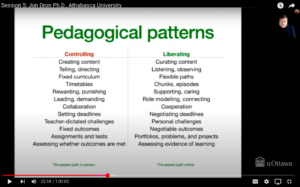The resource that I decided to explore for my first blog post was an online presentation entitled “How Distance Changes Everything,” delivered by Jon Dron. In it, he explains the origins of knowledge spreading, and how this generally manifested as an educated individual standing infant of less-educated individuals and delivering their knowledge. He explains the problems that inherently came along with this system, such as scheduling timetables, a need for space, behaviour expectations, etc., and how these have transitioned into the system that we use today. He then talks about one of the biggest problems of classroom teaching– control. He talks about the ineffectiveness of using extrinsic motivators, such as punishments and rewards, and instead emphasizes the importance of fostering intrinsic motivation in students. I especially appreciated the quote “when you give someone a reward, what you’re saying is that the activity itself isn’t important, the point is to get the reward and not do the activity” (13:30). He then goes on to explain the three pillars of intrinsic motivation, which are autonomy, competence, and relatedness, and how teachers in an in-person classroom must hit all of those targets. He then explains the difference between control in relation to in-person classrooms as opposed to online learning, and how teachers inherently have less control in an online setting. This means that intrinsic motivation in these two scenarios are essentially opposites. As a result of this, he explains that online teachers must embrace this, and give their students as much freedom as possible in order for them to choose how they best learn. He outlines the difference between a controlling and liberating teaching approach with a diagram which I have included below:

As you can see from the text on the bottom of the image, Dron states that the controlling approach is the easiest in an in-person setting; whereas, the liberating approach is easiest in an online setting. He concludes by giving an example of the assessment that he uses in his own online teaching, which is the use of Portfolios of Evidence, similar to the blogs that we are creating for this course, as well as stating that the most important aspect of being a good teacher, either online or in-person, is caring.
It was the latter part of his presentation that I found the most compelling– the difference in effectiveness of the two different types of teaching. For me personally, the freedom that is often given in online courses is not one that I enjoy. I find that I work better when I am given a clear rubric, a clear set of instructions, and am essentially told exactly what to do and when to do it. I have known that this is a weakness of mine for a while, and improving in this area is one of the reasons that I have decided to take these online tech courses over the summer. While I believe that there are students like me who work better in in-classroom settings, I know that this is not the case for everyone. As outlined in the presentation, the freedom that online learning gives can be extremely effective for students who work better at their own pace, and with the freedom to think more creatively.
As a future elementary school teacher, I will evidently be teaching in a classroom setting. That does not mean, however, that I will only use the path that Dron deems easiest for in-person learning. Many of the aspects of online learning that he lists above are ones that I intend to bring into my classroom, such as listening and observing, supporting and caring, and portfolios, problems, and projects. I believe that a combination of the two approaches is the best way to create an effective learning environment, as well as ensure that the needs of all learners are considered and met.